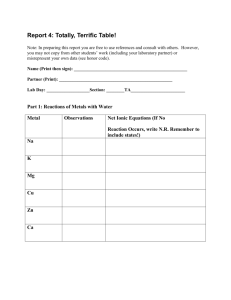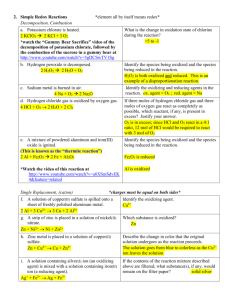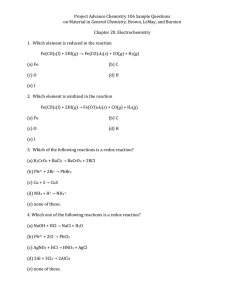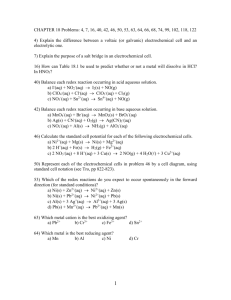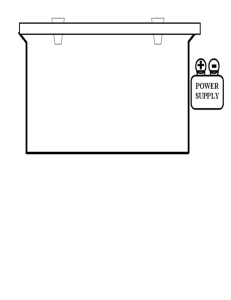Chemistry 101 An Activity Series Dr. Caddell Experimental
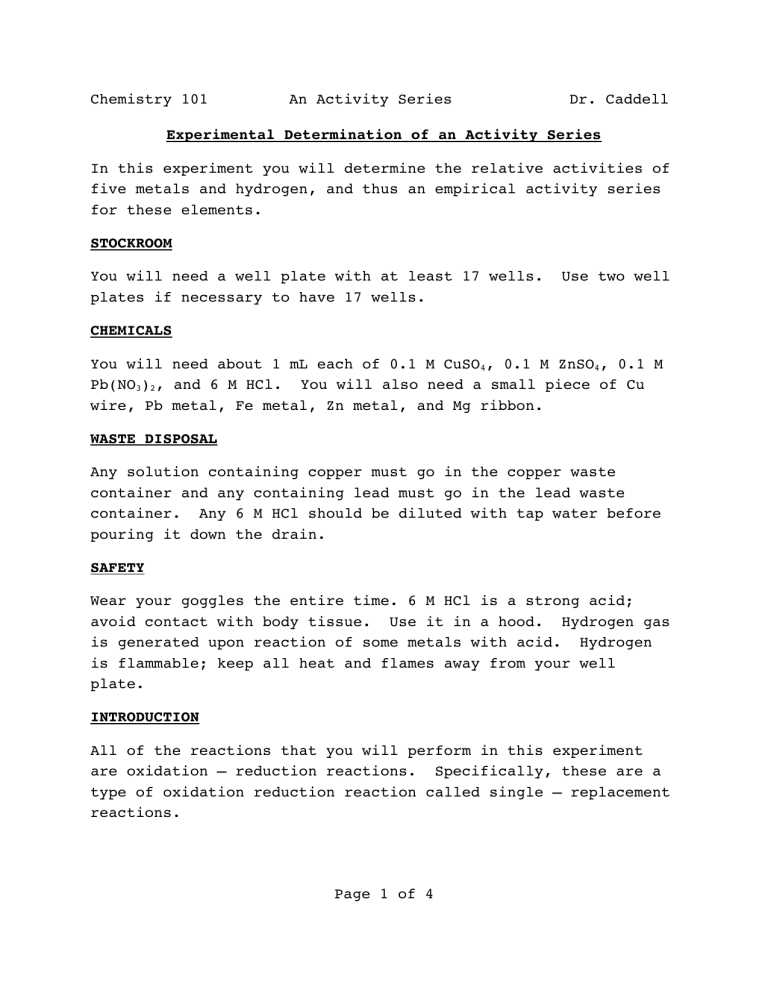
Chemistry 101 An Activity Series Dr. Caddell
Experimental Determination of an Activity Series
In this experiment you will determine the relative activities of five metals and hydrogen, and thus an empirical activity series for these elements.
STOCKROOM
You will need a well plate with at least 17 wells. Use two well plates if necessary to have 17 wells.
CHEMICALS
You will need about 1 mL each of 0.1 M CuSO
4
, 0.1 M ZnSO
4
, 0.1 M
Pb(NO
3
)
2
, and 6 M HCl. You will also need a small piece of Cu wire, Pb metal, Fe metal, Zn metal, and Mg ribbon.
WASTE DISPOSAL
Any solution containing copper must go in the copper waste container and any containing lead must go in the lead waste container. Any 6 M HCl should be diluted with tap water before pouring it down the drain.
SAFETY
Wear your goggles the entire time. 6 M HCl is a strong acid; avoid contact with body tissue. Use it in a hood. Hydrogen gas is generated upon reaction of some metals with acid. Hydrogen is flammable; keep all heat and flames away from your well plate.
INTRODUCTION
All of the reactions that you will perform in this experiment are oxidation – reduction reactions. Specifically, these are a type of oxidation reduction reaction called single – replacement reactions.
Page 1 of 4
Chemistry 101 An Activity Series Dr. Caddell
In single – replacement reaction an element (a metal of a halogen normally) reacts with an ionic compound or acid that contains a like element. That is, if the single element is a metal, the ionic compound or acid will contain a metal. If the single element is a halogen the ionic compound or acid will contain a halogen.
For example:
3Na ( s ) + Au(NO
3
)
3
( aq )
Cl or
2
( g ) + 2NaBr ( aq ) Br
2
( l
Au
) +
( s ) + 3NaNO
2NaCl ( aq )
3
( aq )
In the first equation the sodium has a zero charge on the left side of the arrow, and a +1 charge on the right side of the arrow. The only way this can be is if the sodium atom lost an electron. When a species loses electrons we say that species is
oxidized. Thus sodium is oxidized here.
In the same equation the gold atom has a +3 charge on the left side of the arrow and a zero charge on the right side of the arrow. The only way this can happen is if each gold atom gains
3 electrons. When a species gains electrons we say that species is reduced. Thus gold is reduced in this reaction.
In the second equation the chlorine is reduced and the bromide ion is oxidized. Make sure you understand why this is.
Different elements are easier or harder to oxidize than others.
For example, the following reaction does not occur because gold is harder to oxidize (remove electrons from) than sodium.
Au ( s ) + NaNO
3
( aq ) No Reaction
We say that an element is more active than another element if it is easier to oxidize than that element.
Page 2 of 4
Chemistry 101 An Activity Series Dr. Caddell
In this experiment you will determine the relative activities of
5 metals plus H
2
.
PROCEDURE
Label the rows and columns of your well plate with letters for rows and numbers for the columns.
In your data section, set up a table like the following. Each cell represents a different potential chemical reaction.
The possible combinations are given in the following table.
A
B
C
D
E
1
Zn/Cu 2 + _____ Cu/Zn 2 +
2
_____
Pb/Cu 2 + _____ Pb/Zn 2 + _____
Fe/Cu 2 + _____ Fe/Zn 2 + _____
Mg/Cu 2 + _____ Mg/Zn 2 + _____
Cu/Pb
3
2 + _____
Zn/ Pb 2 + _____
Fe/ Pb 2 + _____
Mg/ Pb 2 + _____
4
Cu/H + _____
Zn/H + _____
Pb/H + _____
Fe/H + _____
Mg/H + _____
Each symbol to the left of the slash represents the solid metal.
The symbol to the right of each slash represents the solution containing that ion.
For example, well A1 in the table above would contain solid zinc and CuSO
4
(aq).
Place 1 small piece of each metal into each well as set up in the table above.
Transfer a small amount of each solution into each well as marked. Add enough solution to cover the piece of metal in the well.
That is, to each well that is labeled with Cu 2+ you add CuSO
4
(aq), for Zn 2+ add ZnSO
4
(aq), For Pb 2+ add Pb(NO
3
)
2
(aq), and for H + add
HCl(aq).
Page 3 of 4
Chemistry 101 An Activity Series Dr. Caddell
Record all observations for each well after 15 minutes in your data table. You will need sufficient space for each well in your data table.
CALCULATIONS
Based on your observations, rank the six elements in order of decreasing activity (from most active at the top to least active on the bottom). You list will look like this:
Most Active (put the symbol for the element here)
?
?
?
Least Active (put the symbol for the element here)
CONCLUSION
Explain your reasoning for your order of activity. Make sure to explain in detail the placement of each element.
Page 4 of 4
